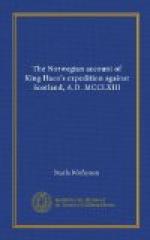The initial letters, in some places, are ornamented with historical miniature paintings. In page 35, there is a representation of the birth of Trygvason; and, at the bottom of the leaf, there is a unicorn and a lion. 217. An archer shooting. 272. Orme Storolfson carrying off a hay-cock. 295. Haldan the Black beheading the Norwegian princes; one of them is represented on his knees, dressed in a red cap, a short doublet, and in red trousers reaching down to the middle of his legs. 310. Three men armed with swords, and battle axes, dispatching St Olave at Sticklestad; at the bottom of the page a man killing a boar, and another fighting with a mermaid. 650. Haco creating Sculi a Duke. Sculi is drawn with a garland, or coronet, and receiving a sword, together with a book by which he is to swear. Most of the figures, in these paintings, are depicted in armour or mail; their helmets are sometimes conical, sometimes like a broad-brimmed hat; their defensive armour is generally a round target, and a two-handed sword. This venerable volume, the noblest treasure of northern literature now existing, though wrote in a very small character, and much abbreviated, consists of 960 columns, two to every page.
* * * * *
THE
HISTORY
OF THE
NORWEGIAN EXPEDITION
AGAINST
SCOTLAND,
MCCLXIII.
At the time that King Haco ruled over Norway, Alexander, the son of William King of Scotland, was then King of Scotland. He was a great Prince, and very ambitious of this world’s praise. He sent, from Scotland in the Western sea, two Bishops to King Haco. At first they begged to know if King Haco would give up those territories in the Hebrides,[1] which King Magnus Bare-foot had unjustly wrested from Malcolm, Predecessor to the Scottish King. The King said that Magnus had settled with Malcolm, what districts the Norwegians should have in Scotland, or in the Islands which lay near it. He affirmed, however, that the King of Scotland had no sovereignty in the Hebrides at the time when King Magnus won them from King Godred,[2] and also that King Magnus only asserted his Birthright. The commissioners then said, that the King of Scotland was willing to purchase all the Hebrides from King Haco, and entreated him to value them in fine silver. The King replied, he knew no such urgent want of money as would oblige him to sell his inheritance. With that answer the messengers departed. From this cause some misunderstanding arose between the Kings. The Scottish Monarch, however, frequently renewed the negotiation, and sent many proposals; but the Scots received no other explanation than what is here related.




